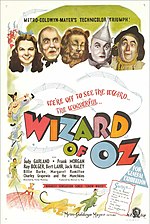The Jitterbug: Difference between revisions
Katieh5584 (talk | contribs) m Reverted edits by 50.202.53.134 (talk) to last revision by GiantSnowman (HG) |
|||
| Line 10: | Line 10: | ||
==History== |
==History== |
||
According to [[Aljean Harmetz]] in her book ''[[The Making of the Wizard of Oz]]'', "The Jitterbug" was an artifact left over from plans in early drafts of the script. The original producers thought that a 1939 audience was too sophisticated to accept Oz as a straight-ahead fantasy; that was why it was reconceived as a lengthy, elaborate dream. Because of a perceived need to attract a youthful audience through appealing to modern [[fad]]s and [[Style (fiction)|styles]], the script originally featured Dorothy's journey as a series of musical contests. A spoiled, selfish [[princess]] in Oz (a part originally written for [[Betty Jaynes (actress)|Betty Jaynes]]) had outlawed all forms of music except [[classical music|classical]] and [[operetta]], and went up against Dorothy in a singing contest in which Dorothy's jitterbug style enchanted listeners and won the [[grand prize]]. The only remnant of this contrivance was "The Jitterbug". |
According to [[Aljean Harmetz]] in her book ''[[The Making of the Wizard of Oz]]'', "The Jitterbug" was an artifact left over from plans in early drafts of the script. The original producers thought that a 1939 audience was too sophisticated to accept Oz as a straight-ahead fantasy; that was why it was reconceived as a lengthy, elaborate dream. Because of a perceived need to attract a youthful audience through appealing to modern [[fad]]s and [[Style (fiction)|styles]], the script originally featured Dorothy's journey as a series of musical contests. A spoiled, selfish [[princess]] in Oz (a part originally written for [[Betty Jaynes (actress)|Betty Jaynes]]) had outlawed all forms of music except [[classical music|classical]] and [[operetta]], and went up against Dorothy in a singing contest in which Dorothy's jitterbug style enchanted listeners and won the [[grand prize]]. The only remnant of this contrivance was "The Jitterbug". |
||
F.M.O.I @almighty_chrisx3 |
|||
==Cutting room floor== |
==Cutting room floor== |
||
Revision as of 16:48, 14 March 2014
"The Jitterbug" was a song sung by Dorothy (with Toto), together with the Scarecrow, Tin Man and Cowardly Lion, that was cut from the soundtrack of the 1939 film The Wizard of Oz. It was both a jazzy development of the plot and a nod to the then popular bobby-soxer dance craze. As the song begins, the four friends see a jitterbug flitting in the shadows from tree to tree and become frightened. The refrain that they sing is: "Oh, the bats and the bees and the breeze in the trees have a terrible, horrible buzz. ... So, be careful of that rascal/Keep away from The Jitterbug." The Jitterbug puts a magical influence on the characters, forcing them to dance the Jitterbug frenetically. Soon there are many jitterbugs, and eventually, everyone collapses from exhaustion and are subdued by the Witch's army of flying monkeys.
The Wicked Witch of the West makes reference to this number in the finished film, telling the leader of the monkeys that she had sent "a little insect to take the fight out of them", a line which is perhaps the most obvious continuity error in the film. The original Baum novel has no reference to Jitterbugs, but the Wicked Witch sends out a swarm of bees to sting Dorothy and her friends to death in Chapter 12, an attack which is thwarted by the Scarecrow and Tin Woodman.
The song has been restored in various stage versions of The Wizard of Oz, including the 1942 Muny production and 1987 RSC version. It does not appear in the 2011 West End version.
An instrumental version of the song appears in the 1939 Our Gang short Time Out for Lessons.
History
According to Aljean Harmetz in her book The Making of the Wizard of Oz, "The Jitterbug" was an artifact left over from plans in early drafts of the script. The original producers thought that a 1939 audience was too sophisticated to accept Oz as a straight-ahead fantasy; that was why it was reconceived as a lengthy, elaborate dream. Because of a perceived need to attract a youthful audience through appealing to modern fads and styles, the script originally featured Dorothy's journey as a series of musical contests. A spoiled, selfish princess in Oz (a part originally written for Betty Jaynes) had outlawed all forms of music except classical and operetta, and went up against Dorothy in a singing contest in which Dorothy's jitterbug style enchanted listeners and won the grand prize. The only remnant of this contrivance was "The Jitterbug". F.M.O.I @almighty_chrisx3
Cutting room floor
The song was recorded in the studio but was evidently cut from the final release print. It was the most famous of a number of cuts that were made to scenes and musical numbers from the film. The conventional reason for its being cut was fear that it would "date" the film too much and/or that the upbeat number was out of place juxtaposed with the group's harrowing experiences in the haunted forest. A more prosaic reason could have been the same argument that was supposedly once made against "Over the Rainbow", that it was a show-stopper that took too much time, or simply that it made the characters appear too silly by having them suddenly break out into a jitterbug dance after all the fantasy that preceded it.
The only film footage that exists is a grainy home movie shot by the film's composer Harold Arlen, taken during dress rehearsal from behind the scenes. It was first featured on a 1983 episode of the TV series Ripley's Believe It Or Not!, has been included as a special feature on all VHS and DVD releases since 1989 and also appears on the deluxe 2-disc Rhino Records 1995 soundtrack release. Additionally, a new recording of the song was featured as the B-side of the original 78 RPM 1939 single release of Over the Rainbow.

